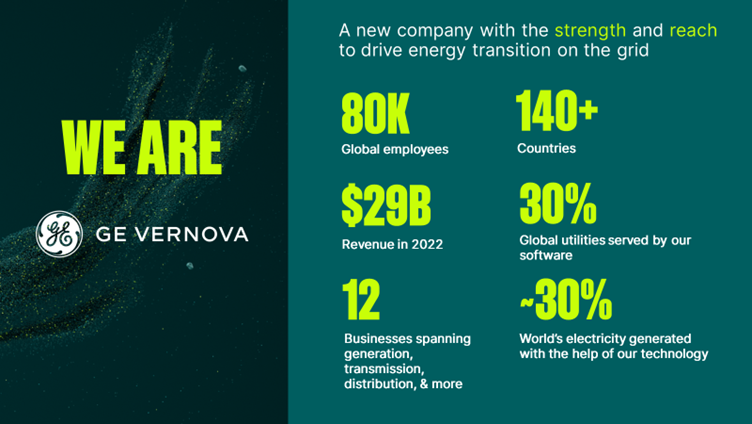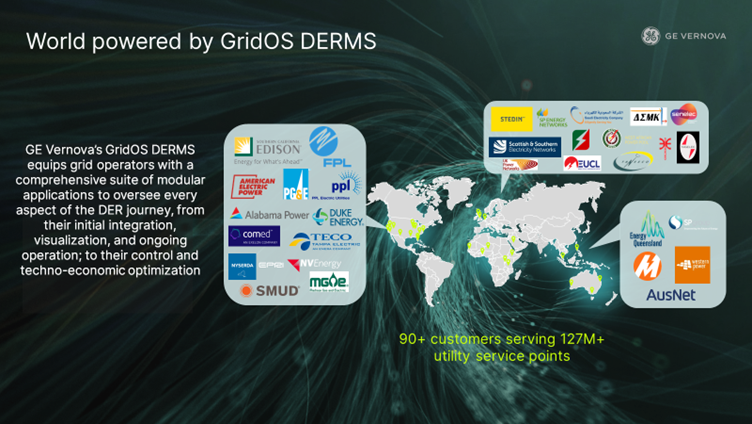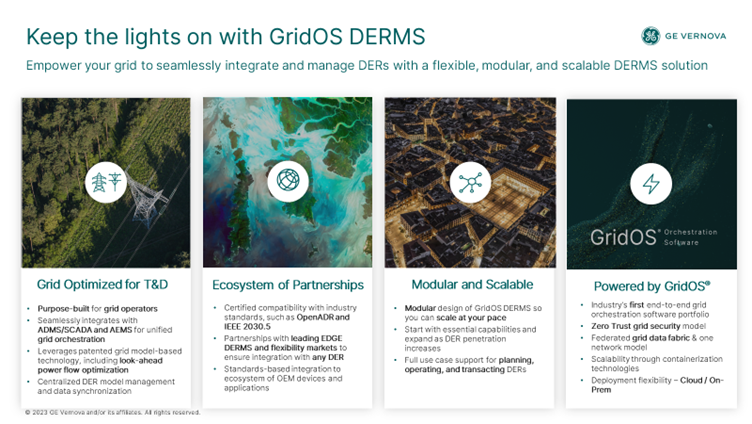GE Vernova: Automated congestion management
The initiative is already a commercially available product and is deployed, deploying, or in negotiation with DSOs in Northern Europe, Australia and USA. It leverages digitisation and its aim is to automate one of the most pressing use-cases faced by DSOs: congestion management.
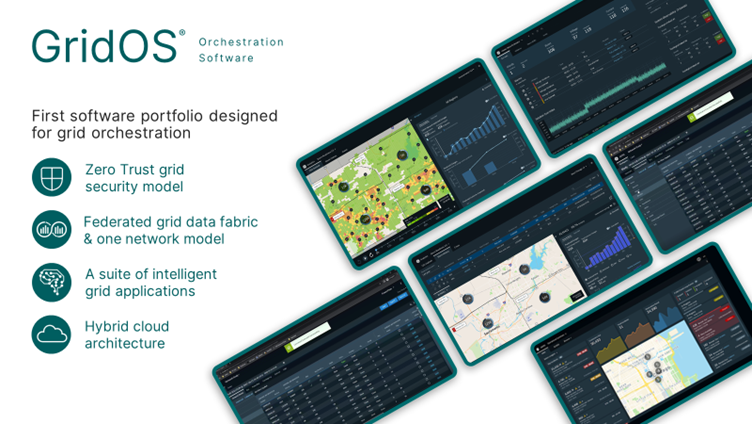

Digitalisation Solution or Approach:
The approach leverages a number of areas of digitisation:
- A single, common network model
- A single source of DER asset data models
- A library of forecasting models
- A Data Fabric bringing together distributed data sources across the enterprise applications
Objectives: The solution for automated constraint management aims to tackle common challenges faced by DSOs:
- A rapid growth in number and severity of congestion areas on distribution networks
- The inability of traditional methods (e.g. grid re-enforcement) to keep pace with the rate of change and demands on the network
- The proliferation of data, often locked away in silos across departments and organisations
- The changing roles, responsibilities and obligations faced by DNOs as they evolve to DSOs
- The demands made on DSOs by their various regulators, governments, and societies as a key enabler of net-zero ambitions
The overall aim is to provide DSOs with a secure, scalable tool to automate the process of efficiently managing congestions through the use of flexibility services.
Context, Challenges, and Framework
Industry Landscape: The European electricity system is profoundly and rapidly reshaping, as it is facing unprecedented changes and need to adapt to face the challenges. The utilities need to achieve CO2 reduction objectives and the electrification and introduction of renewables is the path to follow. However, the integration of high levels of renewables brings network capacities challenges, new electrical patterns, and the appearance of new players, to deal with.
Roadmap:
- DSO Activity: Operate
- Digital Maturity Level: Leading
- Asset: DERMS
Specific Challenges Addressed: The challenge targeted is Congestion Management. This utility challenge is due to integration of high level of electrification and renewables.
Solution Overview
Technological Definition: A DERMS – distributed energy resource management system
DERMS is a technology that transforms DERs from being a challenge, likely to cause issues on the grid, to being a solution, capable of resolving network issues.
DERMS allows utilities to manage the high growth of DERs with ease via a suite of tools to connect, visualize, control, and optimize DERs from both a technical and economic standpoint while meeting regulatory and market requirements, facilitating a cleaner grid, and promoting a sustainable energy future.
DERMS functionality includes DER readiness and NWA (non-wires analysis) planning, automation interconnection assessment, forecasting, optimisation, DER program management, monitoring, measurement and verification and beyond.
DERMS interfaces within front of the meter DERs, behind the meter DERS and aggregators.
Solution Description
GE Vernova’s GridOS DERMS is purpose-built to facilitate the connection and integration of renewables and DERs to the grid, while simultaneously mitigating adverse impacts on grid service quality and minimizing operational costs. It offers a distinct value proposition unparalleled by competing DERMS offerings.
Built on GE Vernova’s GridOS platform, the industry’s first end-to-end grid orchestration software portfolio, GridOS DERMS represents a modern software approach with an innovative architecture designed to accelerate innovation and grid modernization. This transformation ensures that yesterday’s grid is seamlessly adapted to meet the challenges of tomorrow.
Operating within the GridOS framework, it showcases native interoperability, rigorously tested integrations, and a suite of advanced features. These features include tightly integrated network model data, real-time and look-ahead optimization capabilities, a federated grid data fabric, Zero Trust Security measures, and innovative applications for DER control and optimization. It is natively designed to serve the specific needs of grid operators, while its modular structure enables a stepwise approach to introducing necessary capabilities.
GridOS DERMS is built upon the foundation of GE Vernova’s GridOS platform, the industry’s first software portfolio designed for end-to-end electrical grid orchestration of electrons across transmission, distribution, and edge. This platform brings together energy data, network modeling, and AI-driven analytics to power a suite of composable applications that help utilities orchestrate an integrated, flexible, and secure sustainable energy grid.
GridOS DERMS on its own is comprised of the following 8 modules:
- Model Manager
- Program Manager
- Gateway
- Operations
- Forecasting
- Optimization
- Simulation
- Markets Orchestration

Use case overview for Automated Constraint Management
Increasing penetration of Distributed Energy Resources (DERs) and renewable generation dramatically increases the intermittency and dynamics of energy flows on the electrical grids. Consecutively, this intermittency has the potential to cause constraints at different sections of the grid simultaneously and it is no longer viable to operate the Grid manually. Operating the grid solely in real-time and manual intervention increases operators stress and reduces their options to optimize action.
The increased number simultaneous events warrant a solution that allow the operators to automatically manage DER resources with little to no human intervention.
Automated Constraint Management is the ability to automatically identify and resolve real-time and forecasted constraints using DERs. It allows utilities to connect, forecast, optimize, dispatch and monitor DERs to achieve various objectives such as periodically publishing import and export limits, Non-Wires Alternative (NWA) or peak load management and more.
Technological Components:
Fundamental Capabilities of GridOS DERMS to provide Constraint Management
GridOS DERMs allows utilities to manage a complex end to end workflow for constraint management, allowing grid operators to:
- Create Automation configurations for various applications such as optimization based constraint management, rule based constraint management, rule based dispatch and more.
- Define internal (e.g., alarms, topology change, etc.) or external trigger conditions that DERMS will monitor to automatically initiate and execute constraint management workflow.
- Natively Integrate with GE applications to pull information such as alarms and as operated network topology to trigger constraint management.
- Define mode of operation so that DER dispatch can either be fully automated, or with an operator approval
- Make sure that DERMS will adhere to the pre-defined business rules captured by various programs and evaluate real time eligibility based on program constraints and other logical rules such as communication checks to create a list of eligible DERs that can participate in the optimization solution
- Grouping and aggregating the complex capabilities of many and presenting them as a simpler and manageable set of capabilities allowing the utilities to see the total operating limits for the feeder or a group of DERs
The solution comprises several functional modules:
- Model Manager – to ingest, build, and maintain grid network and DER model data
- Forecasting – for accurate and scalable forecasting of load and generation
- Program Manager – to create, track, and manage DER contract and flexibility service data
- Optimisation – to determine flexibility requirements and create optimal schedules
Implementation Details
Phases:
Specific projects usually follow a phased approach, depending on the technological maturity of the existing solutions. Incorporating learning from several projects, at various stages we can identify the following commonly encountered steps:
- Discovery phase – identify the information, data & performance gaps that need to be filled to maximise the value the solution delivers. For example, RTU/substation monitoring data to provide a data source for Forecasting
- Network model management – Deploy foundational elements of solution including Model Manager DERMS module as a tool to ingest, maintain and federate the network model data (as-built, planned, as-operated, as-switched, etc)
- Look ahead elements – Deploy Forecasting and Optimisation DERMS modules to provide the identification of needs – e.g. when, where, & to what extent congestion is expected to occur.
- Solution identification – Deploy Optimisation module functionality, alongside market and contractual information held within Program Manager DERMS module in order to compute the most optimal solution to the congestion identified.
Stakeholders:
A key stakeholder that is important to identify early in the project is the ‘DERMS Operator’ – this may actually not be a defined role in DSOs (yet!) but the importance of the role is key (whatever the naming convention) because they end up being the super-users of the solution.
Key Performance Indicators (KPIs)
Efficiency and Reliability Improvements:
The deployment of automated constraint management typically results in the following business improvements:
- A decrease in non-market based curtailment of generation
- An increase in the number and size of acceptable connection requests in congestion areas
- An increase in the peak load (or generation) that can be safely managed at the congestion zone
- An increase in the liquidity and usage of flexible resources and a subsequent reduction weighted average cost as competition drives down prices
- Better reliability on physical grid infrastructure as it can be operated with larger margins from its rated capacity due to application of flexibility
Lessons Learned and Best Practices
Key Takeaways:
As grid data becomes bigger, faster, and more complex initiatives such as this project to automate congestion management benefit from the application of a specialised software and data management:
Only GE Vernova can offer:
- The first software portfolio designed specifically for grid orchestration.
- The first data fabric designed specifically to enable grid orchestration.
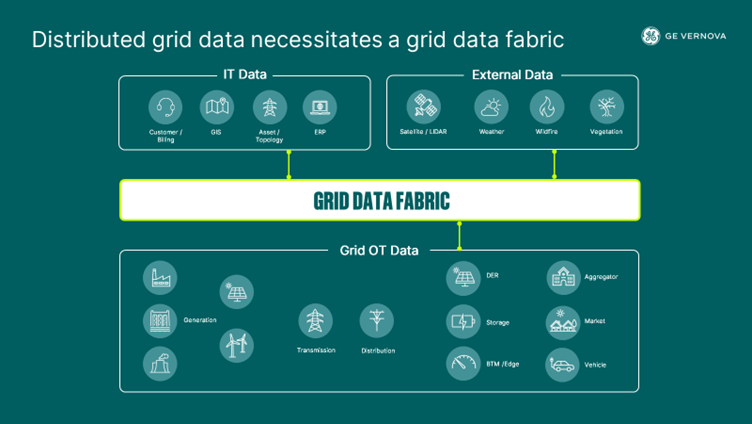
Scalability: the GridsOS DERMS solution for automated congestion management is built on GridOS, and the functional elements are modular, micro-services based and built for scale.
Conclusion
DSO considering similar initiatives, or facing similar congestion management challenges may wish to consider:
- Do they have suitable, scalable and adaptable forecasting capabilities to provide the fundamental look-ahead insight required for a pro-active congestion management solution?
- Is their network and DER data siloed or inaccessible and would they benefit from a grid data fabric architecture – not just for congestion management but to enable new and emerging responsibilities?
- When partnering with technology providers, can they be sure that their data and infrastructure will be protected from cyber and security threats?
